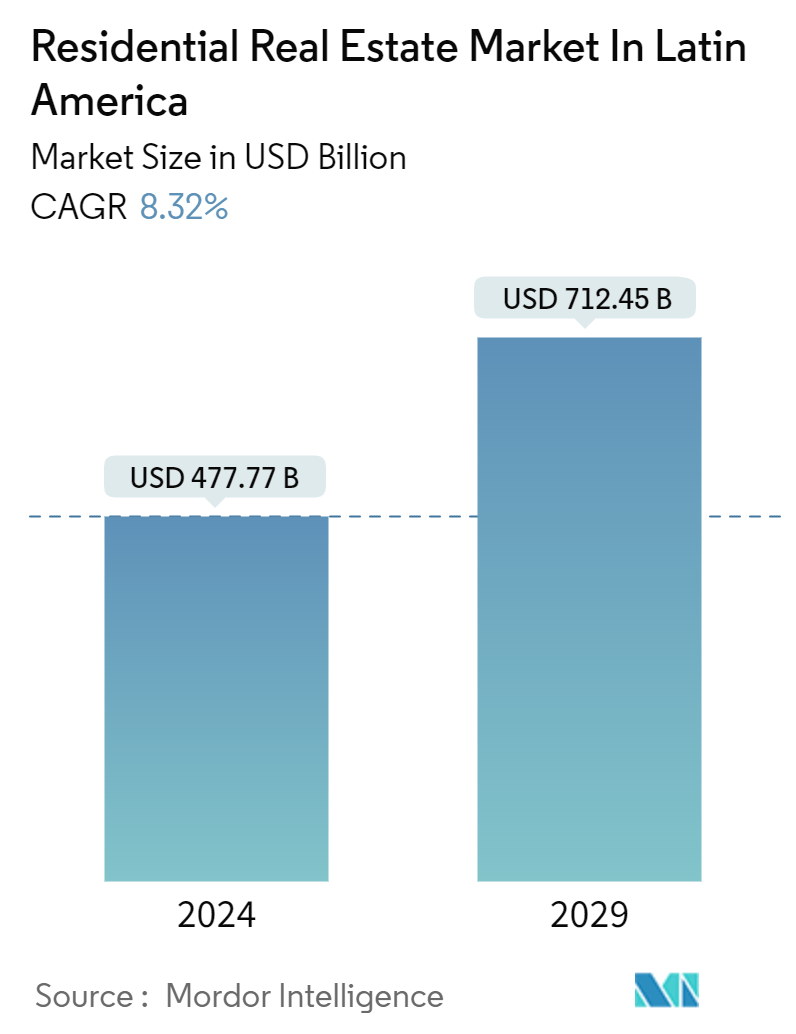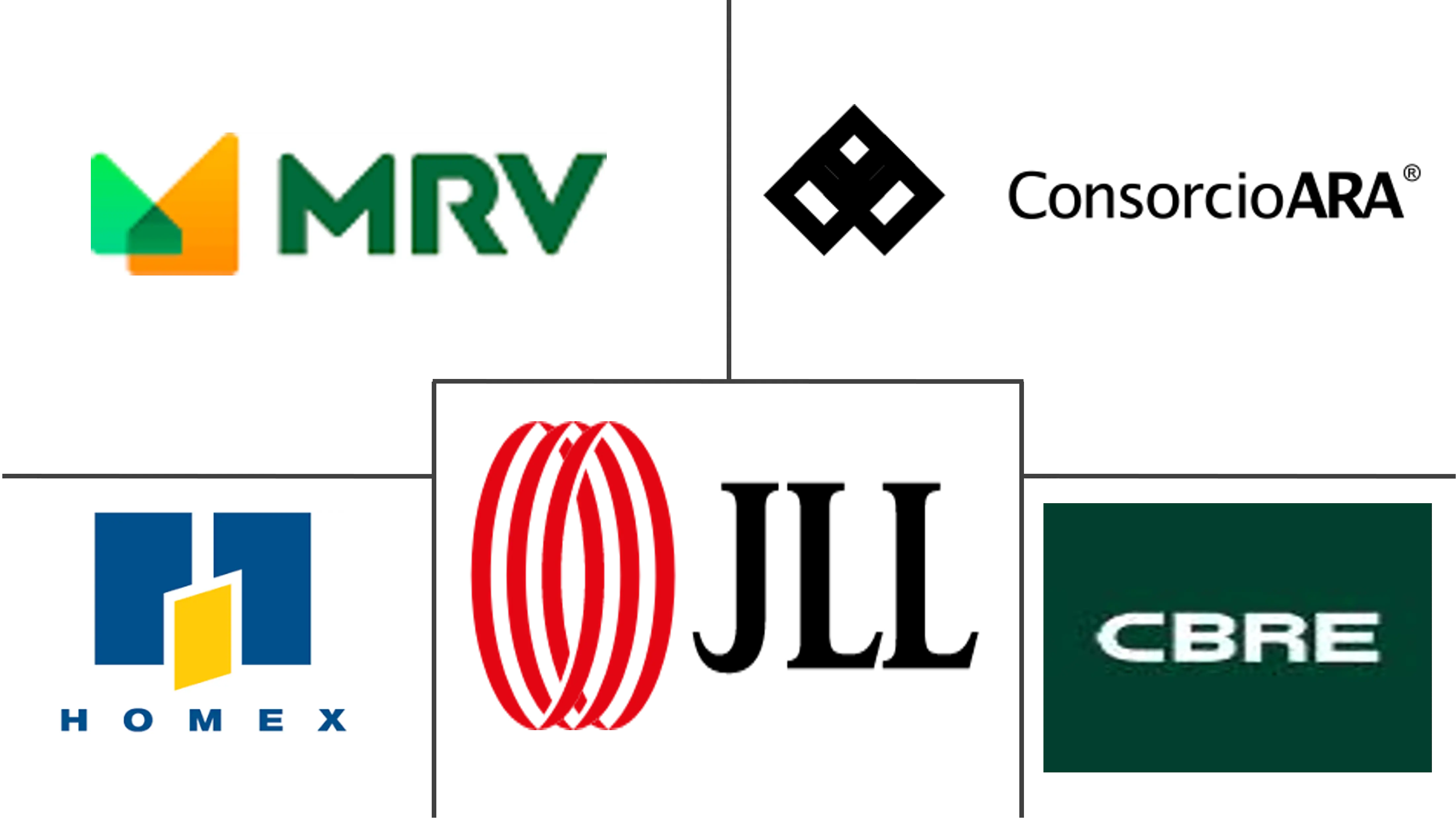Market Size of Residential Real Estate Industry In Latin America

| Study Period | 2020 - 2029 |
| Base Year For Estimation | 2023 |
| Market Size (2024) | USD 477.77 Billion |
| Market Size (2029) | USD 712.45 Billion |
| CAGR (2024 - 2029) | 8.32 % |
| Market Concentration | Low |
Major Players
*Disclaimer: Major Players sorted in no particular order |
Latin America Residential Real Estate Market Analysis
The Residential Real Estate Market In Latin America Industry is expected to grow from USD 477.77 billion in 2024 to USD 712.45 billion by 2029, at a CAGR of 8.32% during the forecast period (2024-2029).
- The market is driven by increased urbanization and a burgeoning middle class. The COVID-19 pandemic impacted the Latin American residential real estate market significantly, with the economic slowdown and increased investor uncertainty serving to dampen growth in the short term. However, the pandemic has stimulated demand for rental properties and accommodation with outdoor space, accelerated the digitalization of the industry, and boosted competition among mortgage lenders.
- South American countries grapple with the familiar challenge of housing affordability, particularly in their urban centers. In 2022, it took an average-income household in Lima, Peru, nearly 19 years to buy a home, while in cities like Buenos Aires, Bogota, and Rio de Janeiro, this stretched to around 30 years. Roughly a quarter of Peruvians opt for renting, a figure that likely surges in major cities like Lima. Renting is notably prevalent in Colombia, with over 40% of homes in several departments being rentals. Bogota, Colombia's capital, emerged as the most lucrative city for rental investments in South America, closely followed by Santiago, Chile.
- Residential real estate prices exhibit significant disparities across and within cities. In 2022, Puerta Madero, located in Buenos Aires, Argentina, emerged as South America's priciest neighborhood for apartment purchases, with an average square meter price nearing USD 6,000. However, Buenos Aires boasted several neighborhoods where apartment prices dipped below USD 2,000. In the city's central region, encompassing San Nicolas and Montserrat, apartment prices ranged from USD 1,700 to USD 1,800 per square meter.
- In September 2023, Montevideo, the capital of Uruguay, emerged as the priciest real estate market in Latin America, commanding an average selling price of USD 3,166 per square meter for apartments. Mexico City, the capital of Mexico, secured the second spot with a price tag of USD 2,948 per square meter. Moreover, as the production and consumption of residential real estate continue to surge, they are poised to fuel the growing appetite among consumers.
Latin America Residential Real Estate Industry Segmentation
Homes or apartments are residential properties. These may include single-family homes, townhouses, or studios. Most residential property owners who own residential property but do not live there will rent it to others to make money from the property.
The report provides a comprehensive background analysis of the market, covering the current market trends, restraints, technological updates, and detailed information on various segments and the competitive landscape of the industry. The report on the Latin American residential real estate market is segmented by type (apartments and condominiums and landed houses and villas) and geography (Mexico, Brazil, Colombia, and the Rest of Latin America).
The report offers the market sizes and forecasts for the Latin American residential real estate market in value (USD) for all the above segments.
| By Type | |
| Apartments and Condominiums | |
| Landed Houses and Villas |
| By Geography | |
| Mexico | |
| Brazil | |
| Colombia | |
| Rest of Latin America |
Residential Real Estate Market In Latin America Size Summary
The Latin American residential real estate market is poised for significant growth, driven by factors such as increased urbanization and a rising middle class. The market, which experienced a temporary setback due to the COVID-19 pandemic, is rebounding with renewed demand for rental properties and accommodations with outdoor spaces. The pandemic also accelerated the digital transformation of the industry and intensified competition among mortgage lenders. Despite challenges like housing affordability in urban centers, the market is witnessing a surge in both residential and commercial property demand, fueled by economic growth and urban migration. Countries like Mexico and Brazil are leading this growth, offering diverse investment opportunities tailored to varying risk appetites.
The market landscape is characterized by competition and fragmentation, with both regional and international players actively participating. Major companies such as JLL, CBRE, and Mrv Engenharia e Participacoes SA are employing strategies like acquisitions and joint ventures to enhance their market presence. Recent initiatives, such as CBRE's Latam-Iberia platform, aim to strengthen investment ties between Europe and Latin America, further stimulating market growth. In Mexico, the Riviera Maya region is highlighted as a promising area for investment, supported by robust economic growth and sustained demand. The market's resilience and adaptability to global economic shifts underscore its potential for continued expansion in the coming years.
Residential Real Estate Market In Latin America Market Size - Table of Contents
-
1. MARKET INSIGHTS AND DYNAMICS
-
1.1 Current Market Scenario
-
1.2 Residential Real Estate Buying Trends - Socioeconomic and Demographic Insights
-
1.3 Government Initiatives and Regulatory Aspects Pertaining to the Residential Real Estate Sector
-
1.4 Insights into the Size of Real Estate Lending and Loan-to-value Trends
-
1.5 Insights into the Interest Rates for the General Economy and Real Estate Lending
-
1.6 Insights into the Rental Yields in the Residential Real Estate Sector
-
1.7 Impact of COVID-19 on the Market
-
-
2. MARKET SEGMENTATION
-
2.1 By Type
-
2.1.1 Apartments and Condominiums
-
2.1.2 Landed Houses and Villas
-
-
2.2 By Geography
-
2.2.1 Mexico
-
2.2.2 Brazil
-
2.2.3 Colombia
-
2.2.4 Rest of Latin America
-
-
Residential Real Estate Market In Latin America Market Size FAQs
How big is the Residential Real Estate Market In Latin America Industry?
The Residential Real Estate Market In Latin America Industry size is expected to reach USD 477.77 billion in 2024 and grow at a CAGR of 8.32% to reach USD 712.45 billion by 2029.
What is the current Residential Real Estate Market In Latin America Industry size?
In 2024, the Residential Real Estate Market In Latin America Industry size is expected to reach USD 477.77 billion.

